| Assassination of James A. Garfield | |
|---|---|
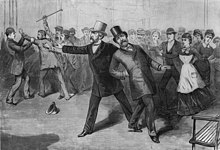 President Garfield with James G. Blaine after being shot by Charles J. Guiteau President Garfield with James G. Blaine after being shot by Charles J. Guiteau | |
| Location | Baltimore and Potomac Railroad Station, Washington, D.C., U.S. |
| Coordinates | 38°53′31″N 77°01′13″W / 38.89194°N 77.02028°W / 38.89194; -77.02028 |
| Date | July 2, 1881, 143 years ago 9:30 am (Local mean time) |
| Target | James Abram Garfield |
| Attack type | Assassination |
| Weapons | British Bull Dog revolver |
| Victim | James Abram Garfield (died on September 19, 1881 as a result of infection) |
| Motive | Retribution for perceived failure to reward campaign support |
| Convicted | Charles Julius Guiteau |
| Verdict | Guilty |
| Convictions | First degree murder |
| Sentence | Death by hanging |
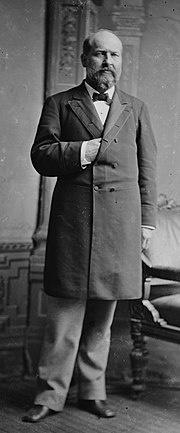
On July 2, 1881, James A. Garfield, the 20th president of the United States, was shot at the Baltimore and Potomac Railroad Station in Washington, D.C., resulting in his death in Elberon, New Jersey, two and a half months later on September 19, 1881. The shooting occurred less than four months into his term as president. He was the second American president to be assassinated, following Abraham Lincoln in 1865. Charles J. Guiteau was convicted of Garfield's murder and executed by hanging one year after the shooting.
Guiteau was an American man who had distributed copies of a speech he wrote aimed at promoting Garfield in the 1880 United States presidential election. Guiteau believed his campaigning had been vital to Garfield's eventual victory, and that Garfield owed him a diplomatic post in Europe for his assistance. After months of failed attempts to solicit such a reward from the Garfield administration, he purchased a revolver and began stalking Garfield with the goal of assassinating him.
After being struck by the bullets, Garfield was carried back to the White House, where he underwent medical treatment for over two months. His condition fluctuated, though generally worsened over time as he began to suffer from sepsis and infection. His treatment in part consisted of doctors trying in vain to find the bullet still lodged in his body; by doing so, they likely aggravated his existing wounds and introduced new sources of infection, decreasing his chances of survival. Garfield was later transported by train to a mansion in New Jersey, where he would die.
Guiteau was arrested immediately after the assassination as he attempted to flee the train station. His trial was widely publicized, and his legal team's attempts to use the insanity defense failed. He was convicted and sentenced to death on January 25, 1882, and hanged on June 20, 1882.
Assassination
Background
Guiteau had turned to politics after failing in several ventures, including theology, a law practice, bill collecting, and spending time in the utopian Oneida Community. Former President Ulysses S. Grant was the early front runner for the Republican presidential nomination in 1880 and was supported by the Stalwart faction. Guiteau became a Stalwart and a Grant supporter, and authored a speech, "Grant against Hancock".
When Grant lost the nomination to dark horse candidate James A. Garfield, who was not affiliated with either the Stalwarts or their rivals the Half-Breeds, Guiteau revised his speech to "Garfield against Hancock" and tried to sign on as a campaigner for the Republican ticket. He never delivered the speech in a public setting, but had it printed (he never paid the bill) and distributed several hundred copies. The speech was ineffective, even in written form; among other problems, Guiteau had made a hurried but incomplete effort to replace references to Grant with references to Garfield. The result was that Guiteau appeared to give Garfield credit for accomplishments that he had originally ascribed to Grant, yet he convinced himself that his speech was largely responsible for Garfield's narrow victory over Democratic nominee Winfield Scott Hancock. Guiteau believed he should be awarded a diplomatic post for his supposedly vital assistance, first asking for a consulship in Vienna, then expressing a willingness to "settle" for one in Paris. He loitered around Republican headquarters in New York City during the winter of 1880–1881, expecting rewards for his speech, but to no avail.

Guiteau arrived in Washington, D.C., on March 5, 1881, the day after Garfield's inauguration, still believing that he would be rewarded. He obtained entrance to the White House and saw the President on March 8, 1881, dropping off a copy of his speech as a reminder of the campaign work which he had done on Garfield's behalf. Guiteau spent the next two months roaming around Washington, staying at rooming houses and sneaking away without paying for his meals and lodging. He passed his days loitering in hotel lobbies to read old newspapers and using hotel stationery to write letters to those who he thought could help him obtain an appointment from Garfield. In addition, he spent time shuffling back and forth between the State Department and the White House and approaching various Cabinet members and prominent Republicans to press his claim, all without success. Guiteau was destitute and increasingly slovenly because he was wearing the same clothes every day, and would walk through the cold, snowy city without overcoat, hat, gloves, or boots. On May 13, 1881, he was banned from the White House waiting room. The following day, he encountered Secretary of State James G. Blaine, who told him, "Never speak to me again on the Paris consulship as long as you live."
Guiteau's family had judged him to be insane in 1875 and attempted to have him committed, but he had escaped. Now his mania took a violent turn, and he decided that he had been commanded by a higher power to kill the President. He later stated, "I leave my justification to God."
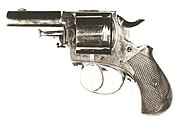
Guiteau borrowed $15 (equivalent to $470 in 2023) from George Maynard, a relative by marriage, then went out to purchase a revolver. He knew little about firearms, but he believed that he would need a large caliber gun. O'Meara's store in Washington provided a choice between two versions of the .442 Webley caliber British Bulldog revolver, one with a wood grip and another with an ivory grip. He favored ivory because he thought that it would look better as a museum exhibit after the assassination, but could not afford the extra dollar, so the store owner dropped the price for him. (The handgun was recovered and displayed by the Smithsonian in the early 20th century, but it has since been lost.) Guiteau spent the next few weeks stalking Garfield and in target practice; the recoil "kick" from the gun almost knocked him over the first time that he fired it. He wrote a letter to Garfield, saying that he should fire Blaine or "you and the Republican party will come to grief". The letter was ignored, as was all the correspondence that Guiteau sent to the White House.
Guiteau continued to prepare carefully; he wrote a letter to William Tecumseh Sherman, the Commanding General of the Army, asking for protection from the mob that he assumed would gather after he killed the President, and he wrote other letters justifying his action as necessary to heal dissension between the factions of the Republican Party. He went to the District of Columbia jail to ask for a tour of the facility where he expected to be incarcerated, but he was told to come back later. He spent the whole month of June following Garfield around Washington. On one occasion, Guiteau trailed Garfield to the railway station as he was seeing his wife, Lucretia Garfield, off to a beach resort in Long Branch, New Jersey; he decided not to shoot the President then, as Lucretia was known to be in poor health and he did not want to upset her.
Shooting


Garfield was scheduled to leave Washington on July 2, 1881, for his summer vacation, which was reported in the Washington newspapers, Guiteau arrived by a hired carriage at the Baltimore and Potomac Railroad Station on the southwest corner of Sixth Street and Constitution Avenue NW in Washington. When Guiteau stepped out of the cab the driver asked him if he should wait for him. He replied that he wouldn't need a ride back as he was going to jail afterwards. Garfield came to the station on his way to his alma mater Williams College, where he was scheduled to deliver a speech before beginning his vacation. He was accompanied by his sons James and Harry, and by Secretary of State James G. Blaine; Secretary of War Robert Todd Lincoln waited at the station to see him off. Garfield had no bodyguard or security detail; early presidents did not employ them, with the exception of Abraham Lincoln during the Civil War.
As Garfield entered the station's waiting room, Guiteau stepped forward and shot the president at point-blank range from behind. Garfield cried out, "My God, what is that?", flinging up his arms. Guiteau fired again, and Garfield collapsed. The first bullet grazed the President's shoulder, and the other struck him in the back, passing the first lumbar vertebra but missing the spinal cord before coming to rest behind his pancreas. Guiteau put his gun back in his pocket and turned to leave via a cab that he had waiting for him outside the station, but he collided with policeman Patrick Kearney, who was entering the station after hearing the gunfire.
Kearney apprehended Guiteau and was so excited at having arrested the man who had shot the president that he neglected to take the gun from him until after they arrived at the police station. Kearney demanded, "In God's name, man, what did you shoot the President for?" Guiteau responded, "I am a Stalwart, and want Arthur for President." The rapidly gathering crowd screamed, "Lynch him", but Kearney and several other police officers took the assassin to the police station a few blocks away. As he surrendered to authorities, Guiteau uttered the exulting words, repeated everywhere: "I am a Stalwart of the Stalwarts! I did it, and I want to be arrested! Arthur is President now!" This statement briefly led to unfounded suspicions that either Vice President Chester A. Arthur or his supporters had put Guiteau up to the crime.
The Stalwarts were a Republican faction loyal to Senator Roscoe Conkling; they supported Grant for a third term in 1880 and strongly opposed Blaine's Half-Breeds. Garfield was unaffiliated with either faction, but Blaine had given his support to Garfield once it became clear that Blaine could not win the presidential nomination. Arthur, a Conkling ally, had been selected as Garfield's running mate to placate the Stalwart faction. As a self-professed Stalwart, Guiteau convinced himself that by removing Garfield, he was striking a blow to unite the two factions of the Republican Party.
Treatment and death
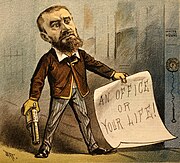
Garfield was carried to an upstairs floor of the railway station, conscious but in shock. One bullet remained lodged in his body, but doctors could not find it. Robert Lincoln was deeply upset, thinking back to the assassination of his father, Abraham Lincoln, 16 years earlier; he said, "How many hours of sorrow I have passed in this town." He would again be near a presidential assassination 20 years later, when President William McKinley was killed at the Pan American Exposition in Buffalo, which Robert was attending.
Garfield was carried back to the White House, and doctors told him that he would not survive the night; nevertheless, he remained conscious and alert. The next morning, his vital signs were good and doctors began to hope for recovery. A long vigil began, and Garfield's doctors issued regular bulletins that the American public followed closely throughout the summer of 1881. Garfield's condition fluctuated; fevers came and went, he struggled to keep down solid food, and he spent most of the summer eating only liquids.
Navy engineers rigged up an air cooler to relieve Garfield from the heat of a Washington summer. Fans blew air over a large box of ice and into the President's sickroom, and the device worked well enough to lower the temperature 20 degrees (Fahrenheit). Doctors continued to probe Garfield's wound with unsterilized fingers and instruments, attempting to find the bullet, and Alexander Graham Bell devised a metal detector specifically to find it. He was unsuccessful, partly because Garfield's metal bedframe made the instrument malfunction, and partly because self-appointed chief physician Doctor Willard Bliss allowed Bell to use the device only on Garfield's right side, where Bliss insisted the bullet had lodged. Bell's subsequent tests indicated his metal detector was in good working order and that he would have found the bullet had he been allowed to use the device on Garfield's left side.
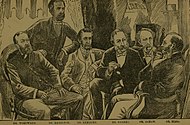
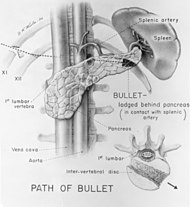
On July 29, Garfield met with his Cabinet for the only time during his illness; the members were under strict instruction from the doctors not to discuss anything upsetting. Garfield became increasingly ill over a period of several weeks due to infection, which caused his heart to weaken. He remained bedridden in the White House with fevers and extreme pains. His weight dropped from 210 pounds (95 kilograms) to 130 pounds (58 kilograms) as his inability to keep down and digest food took its toll. Nutrient enemas were given in an attempt to extend his life because he could not digest food. Sepsis and infection set in, and the President suffered from hallucinations for a time. Pus-filled abscesses spread all over his body as the infections raged.
Garfield's condition worsened under the oppressive summer weather in Washington. On September 6, Garfield was taken by train to Elberon (then part of Long Branch) at the Jersey Shore, where volunteers built a spur line, overnight, from the station to the Francklyn Cottage, a seaside mansion given over to his use. The intent was to help the President escape the Washington heat and humidity, in the vain hope that the fresh air and quiet might aid his recovery. Garfield was propped up in bed before a window with a view of the beach and ocean. New infections set in, as well as spasms of angina. Garfield died of a ruptured splenic artery aneurysm, following sepsis and bronchial pneumonia at 10:35 pm on Monday, September 19, 1881, in Elberon, New Jersey, two months before his 50th birthday. During the 79 days between his shooting and death, Garfield's only official act was to sign a request for the extradition of a forger who had escaped and was apprehended after he fled to Canada.

Most historians and medical experts now believe that Garfield probably would have survived his wound had the doctors been more capable. Unlike their peers in Europe, most American doctors of the day did not believe in anti-sepsis measures or the need for cleanliness to prevent infection. Several inserted their unwashed fingers into the wound to probe for the bullet, and one doctor punctured Garfield's liver in doing so. Also, Bliss had supplanted Garfield's physician Jedediah Hyde Baxter. Bliss and the other doctors who attended Garfield had guessed wrong about the path of the bullet in his body; they had probed rightward into his back instead of leftward, missing the location of the bullet but creating a new channel which filled with pus. The autopsy discovered this error and revealed pneumonia in both lungs and a body that was filled with pus due to uncontrolled sepsis.
The conventional narrative regarding Garfield's post-shooting medical condition was challenged by Theodore Pappas and Shahrzad Joharifard in a 2013 article in The American Journal of Surgery, in which they argued that the President died from a late rupture of a splenic artery pseudoaneurysm, which developed secondary to the path of the bullet adjacent to the splenic artery. They also argued that his sepsis was actually caused by post-traumatic acute acalculous cholecystitis (inflammation of the gallbladder). Based on the autopsy report, the authors speculate that Garfield's gallbladder subsequently ruptured, leading to the development of a large bile-containing abscess adjacent to the gallbladder. Pappas and Joharifard say this caused the septic decline in Garfield's condition that was visible starting from July 23, 1881.
Vice President Arthur was at his home in New York City when word came the night of September 19 that Garfield had died. He said, "I hope—my God, I do hope it is a mistake", but confirmation by telegram came soon after. Arthur was inaugurated early in the morning on September 20, and he took the presidential oath of office from John R. Brady, a New York Supreme Court judge. Arthur then left for Long Branch to pay his respects to Mrs. Garfield before going on to Washington.
Garfield's body was taken to Washington, where it lay in state in the Capitol Rotunda and in the United States House of Representatives chamber before being taken to Cleveland, Ohio, where the funeral was held on September 26.
Trial and execution
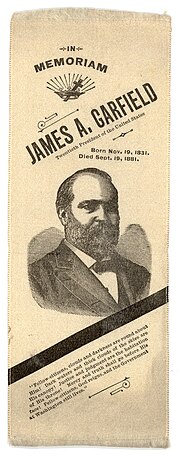
Guiteau went on trial in November, represented by his brother-in-law George Scolville. He received ample media attention during his trial for his bizarre behavior, including constantly insulting his defense team, formatting his testimony in epic poems which he recited at length, and soliciting legal advice from random spectators in the audience via passed notes. Guiteau claimed that he was not guilty because Garfield's murder was the will of God and he was only an instrument of it. He sang "John Brown's Body" to the court. He dictated an autobiography to the New York Herald, ending it with a personal ad for a nice Christian lady under 30. He was oblivious to the American public's outrage and hatred of him, even after he was almost killed twice himself—once while in prison, and again while being transported there. At one point, Guiteau argued that Garfield was killed not by him but by medical malpractice: "I deny the killing, if your honor please. We admit the shooting." Under the felony murder rule, however, Guiteau was still legally responsible for Garfield's death even if it did not occur as the direct result of the shooting. He was housed at St. Elizabeths Hospital in the southeastern quadrant of Washington, D.C., throughout the trial and up until his execution.
Guiteau's trial was one of the first high-profile cases in the United States where the insanity defense was considered. Guiteau vehemently insisted that he had been legally insane at the time of the shooting, but he was not really medically insane, which caused a major rift with his defense lawyers, and which probably contributed to the jury's impression that Guiteau was merely trying to deny responsibility.
Guiteau was actively making plans to start a lecture tour after his release and to run for president himself in 1884; at the same time, he delighted in the media circus surrounding his trial. Guiteau was dismayed when the jury was unconvinced of his divine inspiration, convicting him of Garfield's murder on January 25, 1882, and sentencing him to death. He appealed, but his appeal was rejected, and he was hanged on June 30, 1882, just two days before the first anniversary of the shooting, in the District of Columbia. Guiteau famously danced his way up to the gallows and waved at the audience, shook hands with his executioner, and, as a last request, recited a poem that he had written called "I am Going to the Lordy". He requested an orchestra to play as he sang the poem; it was denied. As per request with the executioner, Guiteau signaled that he was ready to die by dropping the paper.
Aftermath

Part of Guiteau's preserved brain is on display at the Mütter Museum at the College of Physicians of Philadelphia. Guiteau's bones and more of his brain, along with Garfield's backbone and a few ribs, are kept at the National Museum of Health and Medicine, at the Army's Forest Glen Annex in Silver Spring, Maryland. Garfield's assassination was instrumental to the passage of the Pendleton Civil Service Reform Act on January 16, 1883. Garfield himself had called for civil service reform in his inaugural address and supported it as president in the belief that it would make government more efficient. It was passed as something of a memorial to the fallen President. Arthur, himself in poor health by 1884, did not actively seek the Republican nomination which went to James G. Blaine, whom Arthur had retained as his Secretary of State. Blaine went on to lose a close election to Democrat Grover Cleveland.

The Baltimore and Potomac Railroad Station was later demolished. The site is now occupied by the West Building of the National Gallery of Art. The National Park Service in 2018 placed permanent wayside signs to mark the spot of the assassination and to honor Garfield. A few blocks away the James A. Garfield Monument stands on the southwest corner of the U.S. Capitol grounds.
The question of Presidential disability was not addressed. Article II, section 1, clause 6 of the U.S. Constitution says that in case of the "Inability to discharge the Powers and Duties of the said Office, the same shall devolve on the Vice President", but gives no further instruction on what constitutes inability or how the President's inability should be determined. Garfield had lain on his sickbed for 79 days without performing any of the duties of his office except for the signing of an extradition paper, but this did not prove to be a difficulty because in the 19th century the federal government effectively shut down for the summer regardless. During Garfield's ordeal, Congress was not in session and there was little for a president to do. Blaine suggested the Cabinet declare Arthur acting president, but this option was rejected by all, including Arthur, who did not wish to be perceived as grasping for power.
Congress did not deal with the problem of what to do if a president were alive but incapacitated as Garfield was, nor did the Congress take up the question thirty-eight years later, when Woodrow Wilson suffered a stroke that put him in a coma for days and left him partially paralyzed and blind in one eye for the last year and a half of his presidency. The Twenty-fifth Amendment was ratified in 1967 and provides an official procedure when the incapacity of a president is recognized.
Garfield, like many other presidents of his time, often traveled on public infrastructure without any type of personal security protection. It would not be until the assassination of William McKinley some twenty years later that Congress would finally task the United States Secret Service (founded to prevent counterfeiting) with the responsibility of ensuring the president's personal safety.
Notes
- Another source describes Guiteau's revolver as having wood grips.
See also
- Assassination of John F. Kennedy – 1963 murder in Dallas, Texas, U.S.
- Assassination Vacation – 2005 book by Sarah Vowell
- Garfield Tea House – commemorative structure to an assassinated US PresidentPages displaying wikidata descriptions as a fallback
- List of United States presidential assassination attempts and plots
- List of incidents of political violence in Washington, D.C.
- Spoils system – Elected party giving jobs to supporters
References
- Cheney, Lynne Vincent (October 1975). "Mrs. Frank Leslie's Illustrated Newspaper". American Heritage Magazine. Vol. 26, no. 6. Retrieved January 24, 2007.
- "The attack on the President's life". Library of Congress. Washington, D.C. Archived from the original on October 17, 2015. Retrieved January 24, 2007.
- Addams (2009), pp. 26–27
- Faber & Faber (2012), pp. 133
- Millard (2011), p. 57
- Wang (1997), pp. 184–186
- Feldman (2005), p. 86
- Peskin (1978), p. 587
- ^ Millard (2011), pp. 106–107
- Peskin (1978), pp. 588–589
- Peskin (1978), p. 588
- Oliver & Marion (2010), p. 41
- Peskin (1978), p. 589
- Oliver & Marion (2010), p. 42
- Millard (2011), p. 127
- Millard (2011), p. 106
- Resnick (2015)
- Peskin (1978), p. 590
- Millard (2011), pp. 80–82
- Vowell (2005), p. 170
- ^ "Trial Transcript: Cross-Examination of Charles Guiteau". Law2.umkc.edu. Retrieved May 25, 2013.
- Alexander (1882), pp. 107–108
- Reyburn, Robert (March 24, 1894). "History of the Case of President Garfield". Journal of the American Medical Association. XXII. Chicago, IL: American Medical Association: 412. doi:10.1001/jama.1894.02420910009001a. hdl:2027/chi.37460527.
- June (1999), p. 24
- Elman (1968), pp. 166, 171
- Vowell (2005), p. 165
- "Garfield's Assassin". Journal of the Illinois State Historical Society. 70. Springfield, IL: Illinois State Historical Society: 136. 1977. ISSN 0019-2287. OCLC 1588445.
- Vowell (2005), p. 168
- Taylor (2007), pp. 77–78
- Kittler (1965), p. 114
- Vowell (2005), pp. 164–165
- Original letter Archived 2008-02-07 at the Wayback Machine in Georgetown Univ. collection
- Peskin (1978), p. 592
- "A Great Nation in Grief" The New York Times, 3 July 1881.
- ^ Peskin (1978), p. 593
- ^ Vowell (2005), p. 160
- Peskin (1978), p. 581
- Conwell (1881), p. 349
- ^ Peskin (1978), p. 596
- Millard (2011), pp. 189, 312
- "Garfield II: A Lengthy Demise". History House. Archived from the original on December 22, 2014. Retrieved April 25, 2015.
- New York Herald, July 3, 1881
- Millard (2011), p. 230
- Millard (2011), p. 47
- Millard (2011), p. 178
- Peskin (1978), pp. 596–597
- ^ Peskin (1978), p. 597
- O'Reilly, Bill; Zimmerman, Dwight Jon; O'Reilly, Bill Killing Lincoln (2012). Lincoln's last days : the shocking assassination that changed America forever. Internet Archive. New York : Henry Holt and Co. ISBN 978-0-8050-9675-0.
- Peskin (1978), p. 598
- Peskin (1978), p. 599
- Peskin (1978), p. 600
- Vowell (2005), p. 124
- Peskin (1978), p. 601
- Peskin (1978), pp. 601–602
- Millard (2011), p. 194
- Peskin (1978), p. 602
- Millard (2011)
- Peskin (1978), p. 603
- ^ Peskin (1978), p. 604
- Bliss, D. W. "Feeding Per Rectum: As Illustrated in the Case of the Late President Garfield and Others". Washington: N.p., n.d. Rpt. from the Medical Record, July 15, 1882.
- ^ Peskin (1978), p. 605
- Millard (2011), pp. 289–291
- "The Death Of President Garfield, 1881". www.eyewitnesstohistory.com. Retrieved August 3, 2019.
- Millard (2011), p. 313
- Doyle, Burton T.; Swaney, Homer H. (1881). "Removed to the White House". Lives of James A. Garfield and Chester A. Arthur With a brief sketch of the assassin. Washington: R.H. Darby. p. 95. hdl:2027/hvd.32044086981016. OCLC 903876593 – via HathiTrust.
- A President Felled by an Assassin and 1880s Medical Care The New York Times, July 25, 2006.
- Millard (2011), p. 208
- Millard (2011), pp. 25–26
- White (2017), p. 441
- Millard (2011), pp. 312–313
- Pappas, Theodore N.; Joharifard, Shahrzad (July 8, 2013). "Did James A. Garfield die of cholecystitis? Revisiting the autopsy of the 20th president of the United States". The American Journal of Surgery. 206 (4): 613–618. doi:10.1016/j.amjsurg.2013.02.007. PMID 23827513. Retrieved February 16, 2021.
- Peskin (1978), p. 608
- Peskin (1978), pp. 608–609
- Millard (2011), p. 321
- Vowell (2005), p. 173
- Vowell (2005), p. 136
- Millard (2011), p. 250
- Millard (2011), p. 322
- Vowell (2005), p. 175
- "Guiteau Found Guilty," New York Times. January 26, 1882, p. 1
- United States v. Guiteau, 12 D.C. 498 (D.C. Cir. 1882).
- "Last Words of Assassin Charles Guiteau". University of Missouri–Kansas City School of Law. Archived from the original on 13 December 2007. Retrieved 15 December 2007.
- Siera, J.J. "Come see Dead People at the Mutter Museum". Venue Magazine. Rowan University. Issue 41. Volume 2. URL retrieved February 19, 2007.
- Carlson, Peter. "Rest in Pieces". The Washington Post. January 24, 2006. p. C1.
- Peskin (1978), p. 540
- Peskin (1978), pp. 551–553
- Peskin (1978), p. 610
- @NationalMallNPS (July 2, 2021). "The waysides are permanent. Guiteau's revolver was a .442 caliber British Bulldog revolver with ivory grips. After he bought it, Guiteau remarked that it would look good in a museum. It was once part of the Smithsonian collection, but is now lost" (Tweet). Retrieved July 10, 2021 – via Twitter.
- Daley, Jason (November 19, 2018). "Why Doesn't Garfield Assassination Site on the National Mall Have a Marker?". Smithsonian. Retrieved March 4, 2019.
- Vowell (2005), p. 171
- White (2017), p. 440
- President's Commission on the Assassination of President John F. Kennedy (1992). The Warren Commission Report. New York: St. Martin's Press. p. 110. ISBN 0-312-08257-6.
The first congressional session after the assassination of McKinley gave more attention to legislation concerning attacks on the President than had any previous Congress but did not pass any measures for the protection of the President. Nevertheless, in 1902 the Secret Service, which was the only Federal general investigative agency of any consequence at the time, assumed full-time responsibility for the safety of the President.
Cited works
- Addams, Jane (2009). The Selected Papers of Jane Addams. Vol. 2. Urbana, IL: University of Chicago Press. ISBN 978-0-252-03349-0.
- Alexander, H. H. (1882). The Life of Guiteau and the Official History of the Most Exciting Case on Record: Being the Trial of Guiteau for Assassinating Pres. Garfield. Philadelphia, PA: National Publishing Company.
- Conwell, Russell H. (1881). The Life, Speeches, and Public Services of James A. Garfield, Twentieth President of the United States: Including an Account of his Assassination, Lingering Pain, Death and Burial. Portland, ME: George Stinson. OCLC 2087548.
- Elman, Robert (1968). Fired in Anger: The Personal Handguns of American Heroes and Villains. Garden City, NJ: Doubleday & Company.
- Faber, Charles F.; Faber, Richard B. (2012). The American Presidents Ranked by Performance, 1789–2012. Jefferson, NC: McFarland and Company. ISBN 978-0-7864-6601-6.
- Feldman, Ruth Tenzer (2005). James Garfield. Minneapolis, MN: Lerner Publications Company. ISBN 978-0-8225-1398-8.
- June, Dale L. (1999). Introduction to Executive Protection. Boca Raton, FL: CRC Press. ISBN 978-0-8493-8128-7.
- Kittler, Glenn D. (1965). Hail to the Chief!: The Inauguration Days of our Presidents. Philadelphia, PA: Chilton Books.
- Millard, Candice (2011). Destiny of the Republic. Doubleday. ISBN 978-0-385-53500-7.
- Oliver, Willard M.; Marion, Nancy E. (2010). Killing the President: Assassinations, Attempts, and Rumored Attempts on U.S Commander-in-Chief. Santa Barbara, CA: Praeger. ISBN 978-0-313-36474-7.
- Peskin, Allan (1978). Garfield: A Biography. Kent State University Press. ISBN 0-87338-210-2.
- Resnick, Brian (October 4, 2015). "This Is the Brain that Shot President James Garfield". The Atlantic. Washington, DC: Emerson Collective.
- Taylor, Troy (2007). Wicked Washington: Mysteries, Murder & Mayhem in America's Capital. Charleston, SC: The History Press. ISBN 978-1-59629-302-1.
- Vowell, Sarah (2005). Assassination Vacation. Simon and Schuster. ISBN 0-7432-6003-1.
- Wang, Xi (1997). The Trial of Democracy: Black Suffrage and Northern Republicans, 1860–1910. Athens, GA: University of Georgia Press. ISBN 978-0-8203-4206-1.
- White, Richard (2017). The Republic for Which It Stands. The Oxford History of the United States. Oxford University Press. ISBN 978-0199735815.
Further reading
- Hammond, William A.; Ashhurst, Jr., John; Sims, J. Marion; Hodgen, John T. (December 1881). "The Surgical Treatment of President Garfield". The North American Review. 133 (301): 578–610. JSTOR 25101018.
External links
- History House's account of Guiteau's life and the assassination of Garfield, part 1, 2 and 3.
- James A. Garfield On Prospect of Being Assassinated: Original Letters and Manuscripts Archived January 2, 2015, at the Wayback Machine Shapell Manuscript Foundation
- New York Times article reprinting indictment
- New York Times article on shooting at time of shooting
- Garfield's murder and Guiteau's trial at the Crime Library
- Charles Guiteau Trial homepage at the University of Missouri–Kansas City
- Charles J. Guiteau collection at Georgetown University
- "American Experience | Insanity on Trial". PBS. Archived from the original on February 22, 2017. Retrieved September 21, 2015.
- "The Attempt on the President's Life", a September 1881 article about the shooting, printed in The Atlantic
| James A. Garfield | |
|---|---|
| |
| Life | |
| Presidency | |
| Public image | |
| Family |
|
| Assassinations of presidents of the United States | |
|---|---|
| History of the United States | |||||||||||||||||||||||||||||||
|---|---|---|---|---|---|---|---|---|---|---|---|---|---|---|---|---|---|---|---|---|---|---|---|---|---|---|---|---|---|---|---|
| |||||||||||||||||||||||||||||||
| |||||||||||||||||||||||||||||||
| |||||||||||||||||||||||||||||||
| |||||||||||||||||||||||||||||||
- Assassination of James A. Garfield
- Deaths by person in New Jersey
- History of Washington, D.C.
- Incidents of violence against men
- 1881 murders in the United States
- Presidency of James A. Garfield
- Medical malpractice
- 1881 in Washington, D.C.
- July 1881 events
- Political violence in the United States
- Murder in Washington, D.C.
- Assassinations in the United States
- Violence against men in the United States